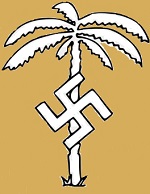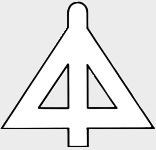Hobby Master HG5104 German Sd. Kfz. 11/4 3-Ton Nebelkraftwagen - 33.PanzerArtillerie, 15.Panzer Division, Deutsches Afrika Korps, North Africa, 1942 (1:72 Scale)
"I do not doubt that the outstanding ability of the designer and at a later date the economic acumen of manufacturers, will make it possible to make available to the German people a car which is low priced and cheap in operation, similar to what American people have enjoyed for a long time..."
- German Chancellor Adolf Hitler at the 26th International Berlin Automobile Show, 1936
 The Sd.Kfz. 11 (Sonderkraftfahrzeug - special motorized vehicle) was a German half-track that saw very widespread use in World War II. Its main role was as a prime mover for medium towed guns ranging from the 3.7 cm FlaK 43 anti-aircraft gun up to the 10.5 cm leFH 18 field howitzer. It could carry eight troops in addition to towing a gun or trailer.
The Sd.Kfz. 11 (Sonderkraftfahrzeug - special motorized vehicle) was a German half-track that saw very widespread use in World War II. Its main role was as a prime mover for medium towed guns ranging from the 3.7 cm FlaK 43 anti-aircraft gun up to the 10.5 cm leFH 18 field howitzer. It could carry eight troops in addition to towing a gun or trailer.
The basic engineering for all the German half-tracks was developed during the Weimar-era by the Reichswehr's Military Automotive Department, but final design and testing was farmed out to commercial firms with the understanding that production would be shared with multiple companies. Borgward was chosen to develop the second smallest of the German half-tracks and built a series of prototypes between 1934 and 1937. However development was taken over in 1938 by Hanomag who designed the main production version, H kl 6.
The chassis formed the basis for the Sd.Kfz. 251 medium armored personnel carrier. Approximately 9,000 were produced between 1938 and 1945, making it one of the more numerous German tactical vehicles of the war. It participated in the Invasion of Poland, the Battle of France, the Balkans Campaign and fought on both the Western Front and the Eastern Front, in North Africa and in Italy.
The Sd.Kfz.11/4 was a modified version of the basic 11/1 3 ton and was used to tow 10cm mortars and later to carry 15cm and 21cm Nebelwerfer rockets, the vehicle was also used to tow the NbW 41 and NbW 42 rocket launchers. Basically identical with the 11/1 except for the rear storage compartments being enlarged to allow room for the rockets. The width of the rear section was also increased to allow the storage of longer rockets.
Pictured here is a 1:72 scale replica of a German Sd. Kfz. 11/4 3-Ton Nebelkraftwagen that was attached to 3.PanzerArtillerie, 15.Panzer Division, then serving with the Afrika Korps in North Africa during 1942.
Sold Out!
Dimensions
Length: 4-1/2 inches
Width: 1-1/2 inches
Release Date: October 2014
 Historical Account: "Panzers Rollen in Afrika Vor" - The 15.Panzer Division was raised from the 33.Infanterie Division in 1936. It mobilized in 1939, but did not take part in the invasion of Poland. In 1940, it participated in the invasions of Belgium and France. It was then reorganized as the 15.Panzer Division in August 1940 at Darmstadt and Landau by incorporating the 8.Panzer Regiment from the 10.Panzer Division and giving up its 110.Infanterie Regiment to the 112.Infanterie Division.
Historical Account: "Panzers Rollen in Afrika Vor" - The 15.Panzer Division was raised from the 33.Infanterie Division in 1936. It mobilized in 1939, but did not take part in the invasion of Poland. In 1940, it participated in the invasions of Belgium and France. It was then reorganized as the 15.Panzer Division in August 1940 at Darmstadt and Landau by incorporating the 8.Panzer Regiment from the 10.Panzer Division and giving up its 110.Infanterie Regiment to the 112.Infanterie Division.
In April 1941, the division began transport to Libya, joining General Erwin Rommel's Deutsches Afrika Korps (DAK) with the 21.Panzer Division and the 90.Leicht Division. By June 15th, the division was deployed in reserve to the south of Bardia, and fought in the successful defense during Operation Battleaxe at Halfaya Pass.
On November 18th, British forces began Operation Crusader with the objective of relieving the besieged forces at Tobruk. The 15th was situated to the east of Tobruk, and by November 20th they joined the 21.Panzer Division to battle the armored forces of the British XXX Corps.
With the XXX Corps situated on the approaches to Tobruk, Erwin Rommel sent his panzer divisions on a rapid advance to the east, threatening the British rear. However the British continued to advance on Tobruk and by November 27th they had linked up with the fortress. The Axis forces were forced to withdraw.
By December 31st, 1941, Rommel's forces halted at the line at El Agheila for refitting his depleted forces. By January 21st he was ready to advance again, and the DAK and Italian forces began another march to the east.







